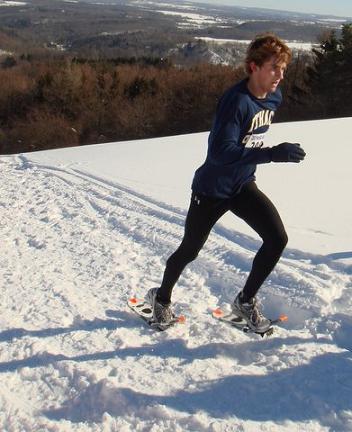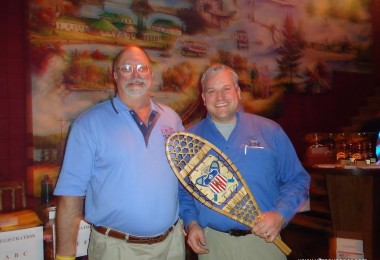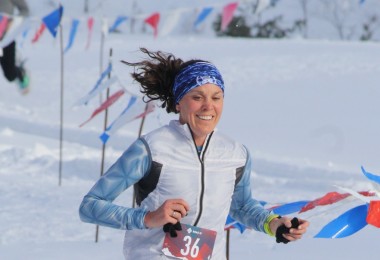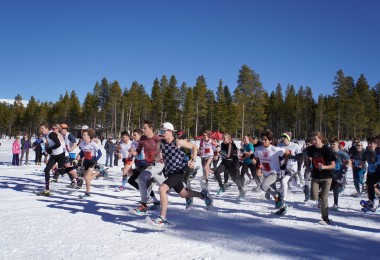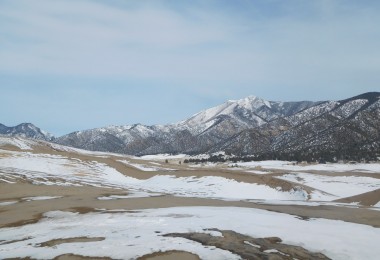The 2010 USSSA PowerSox National Championships knocked the socks off the country’s best snowshoers on a wickedly wavy way worthy of this historic Tenth Anniversa-race. The signature feature, a finish line climb recalling Olympic Ski-Jump hills, gave novel meaning to Host Chary Griffith’s pledge to “fully tour” all possible elevation changes. Extended Special Coverage of this record gathering of all things snowshoe racing is presented by Snowshoe Magazine in Feature Articles, starting right now with The Race: Senior Men’s Championship Race.
Next time, National Championship snowshoe competitors will pay better attention to the name of the venue. “Highland County Park” sounds peaceful enough in lovely Northern New York. But, hidden inside its three thousand acres are a series of meniscus mountains ready to tear both the knees — and heart — from those attacking it.
The rock-n-roll start, uphill by the way, ran through quicksand snow that would have given sheriff Bart of Blazing Saddles a fit . . . it felt as if one could sink up to the neck! Adam Chase, author (check out the new 2nd edition “The Ultimate Guide to Trail Running”) and Atlas snowshoe blazer, called it racing in “mashed potatoes.”
Snowshoes bounced and trounced from deep damp snow trail to more of the same. Scott Gall, making Iowa proud with his challenge for the win, noted a tactic many tried to no avail: moving to one side or the other on the course trail, desperately trying to find firmer footing. “That didn’t work,” he noted, a sentiment racers shared. Adam chimed in, “(the) snow acted like an energy zapping device that sucked the power and drive right out from the bottoms of your snowshoes, and the only consolation was that it did it to everyone . . . there weren’t any easy routes in the many sections that contained that type of snow. We all suffered equally.”
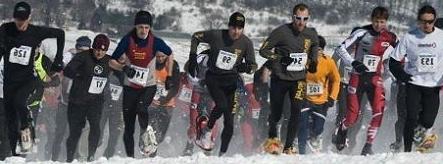
Two-Time National Champion, Greg Hexum, told me, “The part of this course that was designed to be the fastest running and easiest terrain turned out to be the hardest. With the junior boys and girls and the senior women having raced before us (and a big sun), the groomed ski trails returned to deep sugar snow. That made for some extremely challenging running and caused the race to string out faster than it would have otherwise. I think there were a lot of us who were ‘on the ropes’ from the very beginning of the race.”
The course was a true test for 2010 Champion and four-time winner — out of ten years of snowshoe Championship races — Josiah Middaugh. He exclaimed, “The Senior Mens National Championship on Saturday was one of the toughest snowshoe races I have ever done.” This is from a snowshoe champion who celebrated his victory by packing up after the awards ceremony, flying to yet another snowshoe race . . . and winning that, too. Who said the snowshoe season was over?
Josiah is a Champion for the ages in USSSA Snowshoe Racing by winning early and late in the ten year history (2002, Michigan, the Championship’s second year, and this tenth anniversary 2010 race) plus back-to-back Championships as Greg Hexum and Nikki Kimball have done. This victory snatches Nikki Kimball’s sole ownership of “Most Championships Won” as Josiah solidly captured his fourth Gold. Nikki does have one additional medal, silver, for 2003’s runner-up role in Utah to Kelli Lusk, Colorado. 2011 is already shaping up as significant as the top medal count continues.
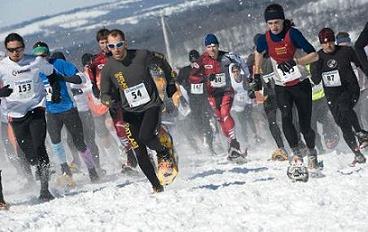
Remarkably, Josiah has quickly recovered from IT-band surgery last November, and only recently began training again. “I had two knee surgeries in November and just started running a little in February. I was a little worried that the pace would be too fast for me right now, but I was ok.” As the saying goes, the hay must’ve already been in his barn, and he used it all up on this demanding layout, chasing and then being chased by Scott Gall. As racers passed mile one, Josiah trailed Scott in their one-two setup, staying that way through the less-packed tracks.
“Scott Gall wasn’t going to leave anything to chance, and he pushed the pace from the very start. The two of us had a gap on a very strong second pack before the first mile. Scott kept the pressure through the first 3 miles, and then I moved into the lead but couldn’t shake him.”
The course just before this point featured an open road that was beginning to show the struggle it was having to keep from losing snow — between plowing and the sun — thus becoming mud. These two had to be flying through that.
Josiah: “We came out on a road and there were some spectators and I think an aid station. Then I led the way into the single-track, switchback climb.”
This snaky-long climb in deep single track where passing was impossible unless a racer stopped and let someone by . . . Not likely for Medal contenders in any class today. Those who had toured the entire course the day prior, like Wisconsin’s Age-Class Silver Medalist, Dave Sykora, reported the uphill wasn’t as steep as it looked on the topography map, but that it was “a gradual long.” Topping that hill comes a blissful let-it-go downhill where their Championship pace must have accounted for the amazing amount of loose snow.
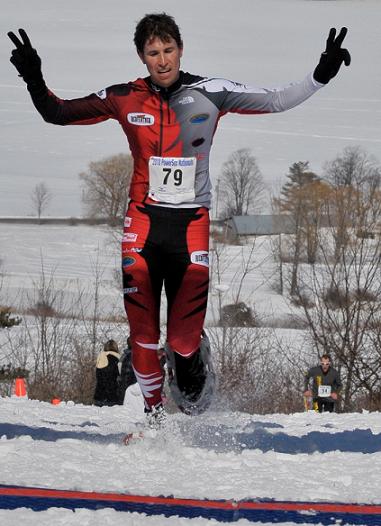
“Scott stuck with me, but I think we were putting more time on the chase pack. Then we crossed the power lines the first time and there was a long downhill. I was finally able to break away from Scott on the long climb back up to the power lines. The snow was so soft that every step was a struggle. I kept working every part of the course and every change in terrain looking for an advantage.”
Some reported 40 climbs over the 6.2-mile test, so there were plenty of opportunities for those changes in terrain. The course then turns sharply up hill, and as Josiah describes, “Finally, I was able to put just a small gap (on Scott) during a long climb around mile four.” Next, the downhill power pole hill immediately after would’ve provided both front-runners, and all others for that matter, with a pleasant and fast leg-stretcher.
Scott was right with him over the must fun section of the entire course, the closing mile and a half in the single track woods before breaking out in the open to the finish. Scott lamented, “I stayed with him pretty dang well out of the woods, down the sharp sled hill, but couldn’t stay attached up that steep finish.”
Josiah described, “I attacked every climb over the second half of the course and a couple seconds here and a couple seconds there added up to just enough to secure the win.” His 52:51 led Scott by 24 ticks for his Fourth Championship win. Scott narrowed his chase against Josiah from an earlier race they had, and in doing so today created one of the most exciting races ever for the USSSA.
How did they manage to do this, pulling away in the last mile and a half, finishing two minutes ahead of the three other National Team Members? Greg Hexum, racing today to tie Josiah’s gold totals, said it well: “They’re triathletes. That commonality has to be helping them on this type of snow conditions,” instantly becoming a spokesperson for all grateful bike manufacturers as snowshoers will now have to add another piece of equipment to their load. Adam noted, “The conditions for the men’s race on Saturday favored multi-sport strength like that of Josiah and Scott and wasn’t as friendly to the likes of Greg Hexum or Kevin Tilton who are more pure runners.”
Josiah concurred, “I think of snowshoe racing as a pure test of fitness. There were several athletes in the race that were faster roadrunners than me but that’s not the only factor in snowshoe racing. I think that is where my triathlon training and altitude training becomes an advantage. Anything that slows the race down benefits me, and the hills and soft snow in New York were the perfect recipe.” Giving homage to the competition in this race and the pressure Scott applied throughout their race, Josiah ended with, “After the National race in New York’s Highland Park I think everything is going to feel a little easier for a while.”
Therefore, snowshoers, the destination for your new bicycles, complimenting your summer cross-training for snowshoe racing, will be the land of no-air, those very tall Vail mountains Josiah calls home. No wonder he can “speak softly and carry a big VO2max,” notes Adam.
There was an excitingly strong 3-4-5 finish as only 27 seconds separated Zachary River, New York, Greg Hexum, Minnesota, and Fred C. Joslyn, New York, to finalize the National Team for the Men. Greg gave this account of chasing the leaders: “Multiple-time U.S. Junior Champion, Zach and I were really hammering up the single track climbs. I think we both thought that we had a chance to get some ground back on Josiah and Scott, but we didn’t make up enough ground to turn it into a four man race for the championship. While Scott and Josiah were clearly impressive, I think Zach Rivers turned the most heads at the race. He has clearly made a huge jump in fitness from his junior level racing. I expect that he will be a force to be reckoned with in many future USSSA Nationals.” Greg concluded, “This was the strongest men’s field ever at a nationals, and I think the national team is the strongest ever for that reason.”
Fred, by the way, is a top marathoner and NCAA Champion in the 5000. He was out of the top five in the first half of the race, passing a fading Scott Jared (Arizona) and Logan Wealing (Colorado) to leap from seventh to secure the fifth and final Men’s National Team spot. At age 26, his snowshoe future is very bright.
Junior Men Results:
Ithaca College made their force felt today as David Geary, NY, was the only racer breaking 28 minutes with a golden strong 28:29. Scott Smolensky won the silver at 29:13, ten seconds better than Coline Kerr’s Bronze performance. The Junior Men and Women enjoyed the same uphill start and big horseshoe-shaped finish . . . if the horseshoe is sitting with the open end up . . . as Seniors. They were also able to enjoy some softer snow, too, though for their event, the first and earliest start, snow remained pretty firm. Seeing Zach Rivers strong third place finish in Seniors has to be motivating for all the Junior racers . . . with training and continued smart work by the racers themselves, the Junior program is producing future champions.
Josiah Heil, WI, brother to Michayla and father, Steve, continues the families commitment to the sport of snowshoeing. David Koutsky, MN, came out for his first ever National event. He told me, “I’m getting new snowshoes.” David helped start snowshoeing at his college, St. Scholastica, Duluth, MN.
Best Lines:
Greg Hexum: “At one point in the race—about a mile and a half in—-I said to myself, ‘If this is too hard for you, Hexum, you should find another sport.’ That snapped me out of my self-pity.”
Jim Johnson, NH, 14th overall and class silver medalist, had a great description of the finishing climb on his blog: “my worst nightmare come true.” Ryan Pauling, NY, edged him out for the gold by 26 seconds. Jeremy Drowne, NY, finished out the group a few seconds later.
Scott Jared, AZ, must have loved the bright sun to remind him of home. Finishing 50 seconds out of the National Team, this snowshoer has extreme mountain running experience, which had to come in handy in this event, keeping him ahead at the finish of a gaining Daniel Craighead, NY, the youngest racer in the field.
Kevin Tilton, winner overall at the Sidehiller in Sandwich, Amber’s qualifying race, finished the Nationals under 50 minutes, the last Senior Man to do so.
Nathaniel Burrell: Was I just testing you, readers? In the Nationals Preview article, I said Alaska had medalists but no national Championships. Thanks for those who paid attention and kindly ‘reminded’ me that Nathaniel Burrell won the National Championship Junior Men’s 2009 Championship. He also represented the entire state of Alaska as their only entrant at this year’s races. How was it? “Tough. Never seen one like it.” He made a common claim: “I was dead on the incline.”
David Sykora, WI: “The course certainly wasn’t a Midwest groomed one. My wooden Iversons worked as good as metal today.”
Mike Bucek: The USSSA Marketing Director is a busy, busy guy with many irons in the fire. Watch for word on a certification course for snowshoers.
Kermit Cadrette (NY): Took a second in class to a much younger, 71 year old John Pelton of Vermont. He told me, “Finished 16 Boston Marathons, never had a course that tough.” Gerald Barney won the 75-79 class over Charles Sabatine. In the ever growing 80 year old class, Richard Busa (MA) won yet another medal, besting New York’s Andy Keefe.
Fleet Feet: New sponsor had a major presence at the race headquarters along with Dion Snowshoes, too. Talked with Ken, their representative, who said the store immediately hopped on board as soon as they learned of the race.
Bob Dion told me of the development, now available on his snowshoes, of a special Velcro product. It has tested very, very well in real life race and field a
pplications and is in full availability. Big news, too, as Dion Snowshoes will become the title sponsor for the Championship Series for the next four years. Look for an announcement, too, as Dion will add another sponsorship in a popular snowshoe series.
Ken Auyer, Auyer Race Timing: A first! This Championship race was the first time Chrono Timing has been used in a snowshoe race on the globe. Such a timing system has been used already on a small marathon known as “The New York Marathon.” How cool was it having results posted virtually as the last entrant crossed the line.
Brent Weigner, WY, just back from Vancouver, liked the course, won class gold over Sykora and James Miner (NY). James, qualifying at Mendon Ponds, called the layout, “Brutal.”
Sylvester Coons, NV, is taking on new responsibilities for the USSSA by becoming manager for the National Teams. This is another key addition, beefing up for the growth in the sport and the visibility of these teams.
Comments on the Nationals? Email me, phillipgary@snowshoemag.com
photo credits:
Brantley Carroll Photography: Top 2. contact at brantleycarroll@mac.com
Josiah finish photo: Scott Mason Photography
photos of the USSSA Nationals, visit http://www.scottmasonphoto.com/galleries Junior Racer: Phillip Gary Smith
www.ultrasuperior.com
www.iHarmonizing.com
